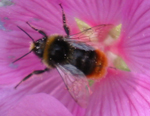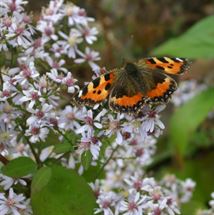
Did you Know..
-
That Bumblebees have been around for millions of years - many flowers evolved in partnership with them.
-
That there are 24 or so species in Britain (the exact number depends how you classify them).
-
That there are at least seven species that do very well in gardens - but only so long as gardeners grow suitable flowers that they can use as a food source.
 |
 |
 |
More Bumblebee Facts
A Bumblebee species new to Britain, the Tree Bumblebee (Bombus hypnorum) moved here just a few years ago, and has spread rapidly. It is a common species in Northern Europe, and is now a common species in Southern Britain and is moving northwards. It is not found in Ireland. It often breeds in cavity walls in houses.
Another bumblebee species, the Buff-tailed Bumblebee (Bombus terrestris) sometimes attempts to establish winter colonies in Southern Britain. Your help is needed to record these colonies more info on my winter bumblebee page.
The Rarer Bumblebees
The rarer bumblebee species became rare in the UK mainly because of habitat loss. They are not generally found in gardens as they need more specialised habitat. Where good habitat is restored, they can bounce back. This is happening in the Romney Marsh area of Kent and Sussex, and in the Western Isles of Scotland.
Flowers for Bumblebees
Flower Partners
Lipped flowers that typically belong to the Sage Family (Lamiaceae) or the Pea family (Fabaceae) are specialised flowers that in many cases have a close relationship with bumblebees or (in some cases) solitary bees. The lip at the front of the flower is the landing platform, the bee then pushes its head into the flower to get at the nectar which is secreted at the back of the flower. At the same time the flower places pollen on to the back of the bee's thorax (neck region). It is very hard for the bee to remove pollen from this spot, and in this way the bee carries pollen from flower to flower and ensures pollination.
Members of the Pea family produce a very nutritious pollen that is vital for the growth of some species of Bumblebees; the wild flowers Bird's Foot Trefoil and Red Clover are prime sources, and the loss of these two plants from pastures and meadows is thought to have contributed to the decline of several bumblebee species. In a garden situation both these wild flowers do best on a poor soil. It is worth establishing them in a lawn (which can be mowed on a high setting while they are in flower) or in a scree bed of gravel, or building rubble. They can be cut back hard after flowering.
Gardening for Bumblebees
Traditional cottage garden flowers and herbs provide perfect forage for bumblebees. For more specific ideas download my Gardening for Bumblebees Factsheet with plant list (pdf).
For more information:
Download my Bumblebee Basics Factsheet (pdf).
Bumblebee books are reviewed in a special Bumblebee section in my wildlife gardening bibliography, which you can download as a pdf from my Recommended Reading page.
ID guides
There are several recent books about bumblebees. The standard one for identification is the Field Guide to the Bumblebees of Britain and Ireland, by Mike Edwards and Martin Jenner, new revised edition 2018. This also has a good section on 'gardening for bumblebees'.
The standard reference work and ID guide covering all wild bees is The Field Guide to the Bees of Britain and Ireland by Steven Falk, illustrated by Richard Lewington. (Published by Bloomsbury, British Wildlife Field Guides, re-issued 2018). This is totally up-to-date, full of illustrations, photographs, distribution maps and interesting information. It is suitable for all levels of reader from the absolute beginner to the expert, and covers solitary bees as well as bumblebees.
For more help with identification the common bumblebee species, go to:
The Natural History Museum's Bumblebee ID page.
Last updated January 2020. © Marc Carlton 2006 - 2020. Terms of Use.


